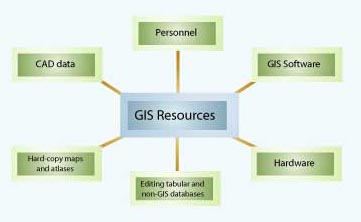ArcUser Online
Evaluating Existing GIS DatasetsEvaluating existing datasets is the first step in bringing the enterprise approach to the decentralized participants. Reviewing all native GIS layers, GIS-enabled spatial databases, associated location-based databases, and other enterprise databases is essential to learn the true status of the data. Some agencies may have extensive data redundancies that can be eliminated or integrated through GIS. The criteria for evaluating the existing GIS data should include foundational requirements, intradepartmental requirements, and strictly departmental requirements. Data layers that fulfill foundation requirements are the key data layers—this is the data required by all participating departments and divisions in the enterprise. The intradepartmental requirement layer is data that is used by more than one department or division. Departmental data only serves a single department's needs. After data layers have been graded, they should be further reviewed for
There is a danger in blindly trusting that the existing GIS data layers are adequate for the implementation in an enterprise GIS. Because these layers were created for a particular purpose, their accuracy or detail may not be sufficient for other users and applications. Therefore, it is always a good practice to review the existing data prior to applying it to the enterprise. However, this review should also take into account that the goal is to get reasonably good data out to the enterprise. This may be accomplished by setting limits for compliance. For example, 80 percent compliance with an accuracy requirement gets data to users but still identifies it for further review so its accuracy can be improved. The data should be cataloged and graded as part of the evaluation so the data can be prioritized for enterprise readiness, update, or elimination. Evaluating GIS ResourcesA complete review of all potential GIS resources should be performed. This review should include all other nontypical GIS-related resources such as (but not limited to)
Evaluating personnel should include skills, abilities, educational attainment, and (most important) experience with GIS, databases, and information systems of the current staff to see how these resources align with the goals of an enterprise GIS. A review of existing and potential job descriptions, new positions (such as a GIS administrator/coordinator), and the training requirements for the potential implementation should also be included. The existing network, servers, tabular and relational databases, asset inventories, non-GIS information, and GIS-related software technologies should be identified and evaluated for potential application for an enterprise GIS. This review should answer some the following types of questions:
The same criteria for evaluating the GIS data—foundational, intra-departmental, and departmental—should be applied to existing tabular and non-GIS databases. External traditional tabular and non-GIS databases should also be included in the evaluation for potential enterprise applications for interdepartmental data sharing through the GIS. The evaluation should also include a review of hard-copy, static, historical, and CAD atlases and maps to ensure that all data is reviewed for potential application to the enterprise GIS. Continued on page 2 |
